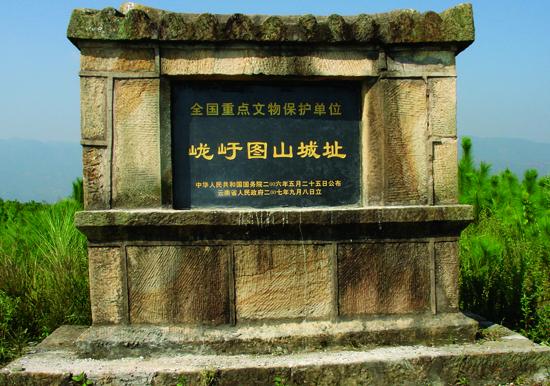Site Features
Longwetu Mountain City Ruins covers about 48,500 square meters. Survey found city walls on the east, north, and west sides but none on the south. The east and west walls were rammed at the junction of steep slopes and flat mountain tops, the north wall at the junction of the flat top and gentle slope outside the city. The walls follow the edge of the flat mountain top, irregular in shape, roughly forming an inverted U.
Cultural Relics
Types of Ruins
Mainly architectural ruins and white sandstone gravel floor pavement remains.
City Walls
The north wall is about 85 meters long, east wall about 380 meters, west wall about 460 meters, with a total length of approximately 925 meters. The west wall was rammed with weathered sandstone and loess mixture; the northeast walls were mainly rammed with white sandstone gravel.
Architectural Remains
Many building ruins lie beneath the surface soil, including large tile debris and extensive architectural foundations. The east end pillar holes measure up to 1 meter in diameter. The entire site floor is evenly paved and rammed with white sandstone gravel.
Statue Relics
Over 180 statues or fragments were excavated, including Buddha, Bodhisattva, Heavenly Kings, and Arhat heads. Among these, 7 are intact statues, 42 relatively complete heads, and 31 fragmented bodies.
Cultural Value
The statues unearthed exhibit clear Tang Dynasty carving style, providing important material evidence for research on Nanzhao’s history and its relation with Buddhism.
Protection Measures
On May 25, 2006, Longwetu Mountain City Ruins was officially listed as a National Key Cultural Relics Protection Unit by the State Council of the People’s Republic of China.
Tourism Information
Location
On the top of Longwetu Mountain west of Tuanshan Village, Weishan Yi and Hui Autonomous County (巍山县), Dali Bai Autonomous Prefecture, Yunnan Province.

 7 Days GolfingTour
7 Days GolfingTour
 8 Days Group Tour
8 Days Group Tour
 8 Days Yunnan Tour
8 Days Yunnan Tour
 7 Days Shangri La Hiking
7 Days Shangri La Hiking
 11 Days Yunnan Tour
11 Days Yunnan Tour
 6 Days Yuanyang Terraces
6 Days Yuanyang Terraces
 11 Days Yunnan Tour
11 Days Yunnan Tour
 8 Days South Yunnan
8 Days South Yunnan
 7 Days Tea Tour
7 Days Tea Tour
 8 Days Muslim Tour
8 Days Muslim Tour
 12 Days Self-Driving
12 Days Self-Driving
 4 Days Haba Climbing
4 Days Haba Climbing
 Tiger Leaping Gorge
Tiger Leaping Gorge
 Stone Forest
Stone Forest
 Yunnan-Tibet
Yunnan-Tibet
 Hani Rice Terraces
Hani Rice Terraces
 Kunming
Kunming
 Lijiang
Lijiang
 Shangri-la
Shangri-la
 Dali
Dali
 XishuangBanna
XishuangBanna
 Honghe
Honghe
 Kunming
Kunming
 Lijiang
Lijiang
 Shangri-la
Shangri-la
 Yuanyang Rice Terraces
Yuanyang Rice Terraces
 Nujiang
Nujiang
 XishuangBanna
XishuangBanna
 Spring City Golf
Spring City Golf
 Snow Mountain Golf
Snow Mountain Golf
 Stone Mountain Golf
Stone Mountain Golf















